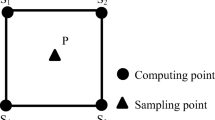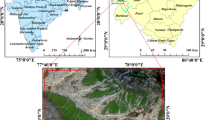Abstract
Digital elevation models (DEMs) are still an important and current source of information for digital soil mapping and the modeling of soil processes. The grid DEM is often interpolated from contour lines. The contour sampling step becomes an additional interpolation parameter which can play an important role. The objective of this paper is to optimize the interpolation parameters of the Regularized spline with tension (RST) method, in order to prepare a DEM suitable as an input for erosion modeling. Two contrasting cases, with and without a reference DEM, were investigated. If a reference DEM was available, good results of interpolation were reached both by small and larger sampling steps. In the second case, it was found that small sampling steps should be avoided. The influence of the sampling was demonstrated by topographic potential for erosion and deposition.




Similar content being viewed by others
References
Ardiansyah POD, Yokoyama R (2002) Dem generation method from contour lines based on the steepest slope segment chain and a monotone interpolation function. ISPRS J Photogramm Remote Sen 57:86–101
Cebecauer T, Hofierka J, Šúri M (2002) Processing digital terrain models by regularized spline with tension: tuning interpolation parameters for different input datasets. In: Proceedings of the open source GIS—GRASS users conference 2002, Trento, Italy
Davis AC, Hinkley DV (1997) Bootstrap methods and their application. Cambridge University Press, Cambridge
Dubrule O (1983) Two methods with different objectives: splines and kriging. Math Geol 15(2):245–257
Gong JY, Li ZL, Zhu Q, Sui HG, Zhou Y (2000) Effects of various factors on the accuracy of DEMs: an intensive experimental investigation. Photogramm Eng Remote Sens 66(9):1113–1117
GRASS Development Team (2008) Geographic resources analysis support system (GRASS) software. Open Source Geospatial Foundation Project. http://grass.osgeo.org
Hofierka J, Cebecauer T (2007) Spatial Interpolation of elevation data with variable density: a new methodology to derive quality DEMs. IEEE Geosci Remote Sens Lett 4(4):117–121
Hofierka J, Cebecauer T, Šúri M (2007) Optimisation of interpolation parameters using a cross-validation. In: Peckham RJ, Jordan G (eds) Digital terrain modelling—development and applications in a policy support environment lecture notes in geoinformation and cartography. Springer, Berlin, pp 67–82
Kučera K (1961) Kritéria přesnosti topografického mapování v měřítku 1:000 a 1:10000. In: Sborník výzkumných prací IV. Praha, VÚGTK
Lloyd CD, Atkinson PM (2002) Non-stationary approaches for mapping terrain and assessing prediction uncertainty. Trans GIS 6(1) 17–30
Mitáš L, Mitášová H (1999) Spatial interpolation. In: Longley P, Goodchild MF, Maguire DJ, Rhind DW (eds) Geographical information systems: principles, techniques, management and applications, geoinformation international. Wiley, New York, pp 481–492
Mitášová H, Mitáš L (1993) Interpolation by regularized spline with tension: I. theory and implementation. Math Geol 25:641–655
Moore ID, Wilson JP (1992) Length-slope factors for the revised universal soil loss equation: simplified method of estimation. J Soil Water Conserv 47:423–428
Neteler M, Mitasova H (2008) Open source GIS: a GRASS GIS approach. In: The international series in engineering and computer science, 3rd edn, vol 773. Springer, New York
Olea R (2007) Sampling design optimization for spatial functions. Math Geol 1:369–392
Oswald H, Raetzsch H (1984) A system for generation and display of digital elevation models. Geo-Process 2(2):197–218
Šíma J, Egrmajerová L (2004) Ověření přesnosti digitálního modelu reliéfu Základní báze geografických dat. Geodetický a kartografický obzor, ročník 50/92, číslo 11, pp 213–230
Talmi A, Gilat G (1977) Method for smooth approximation of data. J Comput Phys 23:93–123
Wahba G (1990) Spline models for observational data. In: CNMS-NSF regional conference series in applied mathematics, vol 59. SIAM, Philadelphia, Pennsylvania
Weibel R, Heller M (1991) Digital terrain modelling. In: Maguire DJ, Goodchild MF, Rhind WD (eds), Geographical information systems: principles and applications, vol 1. Longman, London, pp 269–297
Wilson RG, Gallant JC (2000) Terrain analysis, principles and applications. Wiley, New York
Acknowledgements
This contribution was supported by the grant project GAUK 43-259155 to Stanislav Bek and MSM0021620855 to Josef Ježek.
Author information
Authors and Affiliations
Corresponding author
Rights and permissions
About this article
Cite this article
Bek, S., Ježek, J. Optimization of interpolation parameters when deriving DEM from contour lines. Stoch Environ Res Risk Assess 25, 1049–1055 (2011). https://doi.org/10.1007/s00477-011-0482-8
Published:
Issue Date:
DOI: https://doi.org/10.1007/s00477-011-0482-8




